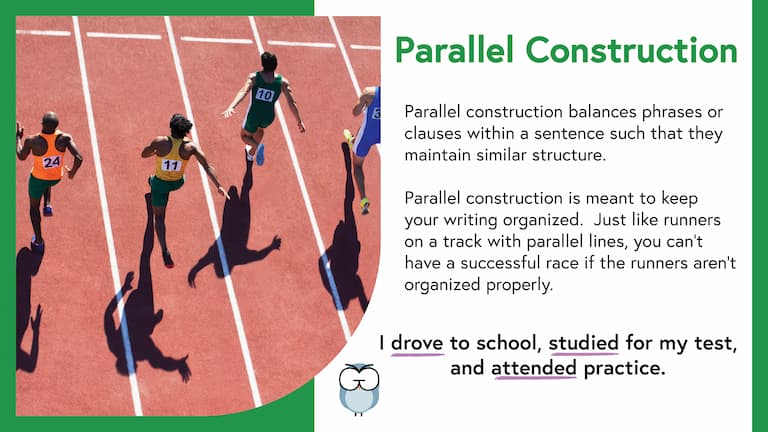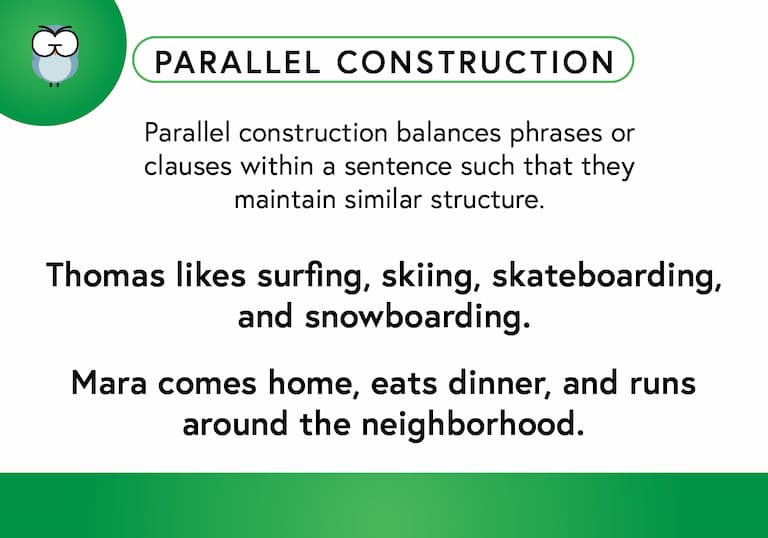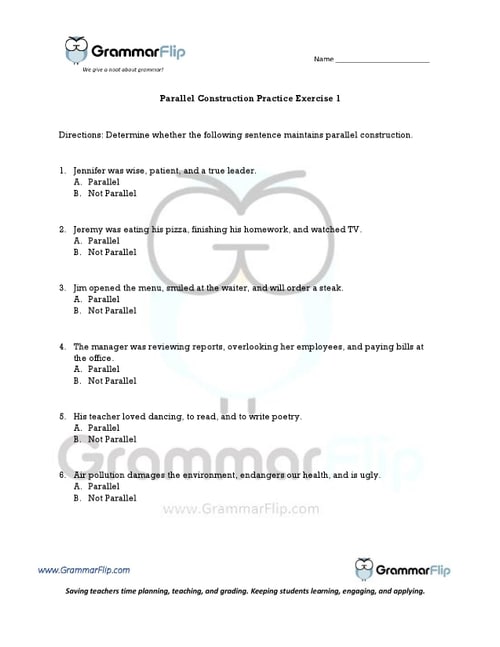What is Parallel Construction?
Parallel construction involves balancing phrases or clauses within a sentence such that they maintain similar structure.
Some examples of parallel construction would be the following:
Jacob’s presentation was cohesive, captivating, and funny.
Thomas likes surfing, skiing, skateboarding, and snowboarding.
Every night, Mara gets home, eats dinner, and runs around the neighborhood.
The judges tasted each dish, took careful notes, and selected a winner.
Long-Form Videos: Parallel Construction
Long-form instructional video lessons allow students to engage with grammar concepts in more depth and detail.
This format provides students with a stronger foundation and a more comprehensive understanding of parallel construction.
Short-Form Videos: Parallel Construction
Short-form videos are an excellent way to review grammar concepts. Our two-minute instructional videos help students review the concept of parallel construction to further solidify their understanding.
Memorable Images: Parallel Construction

The use of images to connect visual cues with concepts makes it simpler for students to grasp and remember key ideas. GrammarFlip’s memorable images create visual associations that make parallel construction more engaging and easier to retain.
Definition Cards: Parallel Construction
Definition cards reinforce grammar concepts by providing clear and concise explanations that students can easily reference for quick review and better retention. GrammarFlip’s definintion cards help students review the concept of parallel construction to further solidify their understanding.

Why You Should Use Parallel Construction in Your Writing
Using parallel construction makes your writing clear and understandable to your reader. The word “parallel” means to keep moving in the same direction at an equal distance apart from one another. We can apply this term to grammar to indicate a “consistency” in the words or phrases we use within a single sentence. By keeping the types of the words or phrases parallel or consistent, your reader knows what to expect as he progresses through a sentence. Take the following sentences for example:
Incorrect: Andrea liked jumping rope, climbing boulders, and ride bikes.
Parallel: Andrea liked jumping rope, climbing boulders, and riding bikes.
Notice how the verbs in the first sentence – “jumping,” “climbing,” and “ride” – are not consistent (ie, not parallel) meaning they are not all in the same tense. We can correct this inconsistency or lack of parallelism by making all of the verb tenses the same.
Let’s take a look at another example:
Incorrect: Jaden goes to school, does his classwork, and played on the playground.
Parallel: Jaden goes to school, does his classwork, and plays on the playground.
In this sentence, notice how the verbs in the first sentence – “goes,” “does,” and “played” – are in both the present tense and past tense. They’re not parallel with one another We can correct this by making all of the verb tenses the same.
Be sure to use parallel construction to keep your writing clear and cohesive.
Download a Free Worksheet on Parallel Construction!
Click the image below to download your free worksheet on parallel construction!

In search of a grammar and writing program for your high school students?
Explore More GrammarFlip Lessons!
Parts of Speech lessons provide the building blocks of grammar. GrammarFlip covers these topics in detail to ensure a solid foundation is built. First time learners and students seeking to review the parts of speech can both benefit from the instructional videos and slide show reviews.
Parts of the Sentence lessons are critical for understanding how the parts of speech function in language construction. From the basic to the advanced, these lessons will cover a wide range of grammar topics that can be used in any grade level or classroom.
Mechanics and Usage lessons equip students with the necessary skills to communicate clearly to all audiences. With a focus on the application of these concepts in student writing, these lessons tie together both simple constructions of grammar as well as the more complex such that any age or skill level of student will benefit.


